Hurricane eMatrix
List of Activity Sheets » Building assessment, restoration and demolition
Mold Remediation
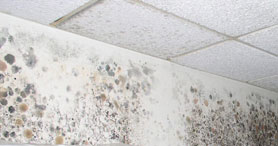
This picture shows actual disaster site work conditions and may not illustrate proper safety and health procedures.
Activity Description
- This activity sheet is for response and recovery workers trained to conduct mold remediation. For some operations or situations other activity sheets also apply; see related activity sheets below.
- Mold abatement activities might be required after any disaster that results in substantial water damage inside buildings, such as Hurricanes Katrina and Rita (2005). Molds grow rapidly on wet or damp materials after natural disasters that involve flooding or high humidity. Certain molds can cause allergy symptoms in some individuals. Some molds produce toxins, but the effect of these toxins in occupational exposure is still not well defined. As a result, mold remediation could be necessary to return many living and working spaces to a serviceable condition and make them suitable for occupancy.
- Mold remediation response and recovery workers may choose to clean materials that can be dried out, fully cleaned, and reused. The drying and cleaning steps can involve the use of blowers, manual scrubbing, and biocides.
- Building materials that cannot be dried and fully cleaned are removed using methods intended to minimize occupant exposure to high concentrations of spores. Removal often involves activities typical of the construction industry. Some situations will require extra precautions similar to those used for handling asbestos- or lead-containing materials to limit the distribution of airborne mold spores.
- Use special care when removing materials that are still damp. Wet materials will be heavier than when dry. Additionally, after a flood, wet materials might be contaminated with any other hazardous substance present in floodwaters.
- Response and recovery workers conducting this operation may be employed by Federal, State, local, and private employers. Review How to Use This Matrix in the introduction for a discussion of how this information may apply to different workers.
About the Activity Sheet
This activity sheet does not provide an in-depth analysis of OSHA standards and regulations and cannot address all hazards. It does not increase or diminish any OSHA requirement or employer obligation under those requirements. It is intended as a guide and quick reference for employers and response and recovery workers. The Matrix captures major activities involved in hurricane response and recovery, highlights many of the hazards associated with them, and recommends beneficial work practices, personal protective equipment (PPE), and other exposure control methods. Employers must evaluate the specific hazards associated with the job/operation at the site where the work is being performed.
Employers are responsible for providing a safe and healthful workplace for their workers. OSHA's role is to assure the safety and health of America's workers by setting and enforcing standards; providing training, outreach, and education; establishing partnerships; and encouraging continual improvement in workplace safety and health.
The Hazard Exposure and Risk Assessment Matrix for Hurricane Response and Recovery Work provides a general overview of particular topics related to current OSHA standards. It does not alter or determine compliance responsibilities in OSHA standards or the Occupational Safety and Health Act of 1970, or the equivalent State Plan standards and requirements. Because interpretations and enforcement policy may change over time, you should consult current OSHA/State Plan administrative interpretations and decisions by the Occupational Safety and Health Review Commission and the courts for additional guidance on OSHA compliance requirements. Employers should modify their procedures as appropriate when additional, relevant information becomes available.
General Recommendations
Key Engineering Controls and Work Practices. See general recommendations document.
Personal Protective Equipment. The general PPE is recommended for all response/recovery tasks/operations; only the additional PPE that may be needed for a specific hazard is noted below
General PPE includes:
- Hard hat for overhead impact or electrical hazards
- Eye protection with side shields
- Gloves chosen for job hazards expected (e.g., heavy-duty leather work gloves for handling debris with sharp edges and/or chemical protective gloves appropriate for chemicals potentially contacted)
- ANSI-approved protective footwear
- Respiratory protection as necessary—N, R, or P95, filtering facepieces may be used for nuisance dusts (e.g., dried mud, dirt and silt) and mold (except mold remediation). Filters with a charcoal layer may be used for odors.
Recommendations Specific to Hazards Associated with Mold Remediation
Key Engineering Controls and Work Practices
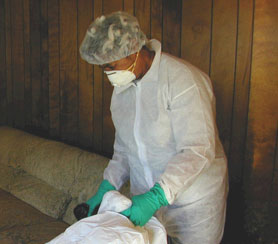
- Discard all water-damaged materials, materials that are visibly coated with mold that cannot be properly cleaned, such as porous materials (e.g., carpeting, drywall, insulation), and materials that have been wet for more than 48 hours
- Wrap and seal the items that will be discarded in plastic bags or sheets to reduce the spread of spores. These materials can usually be discarded as ordinary debris
- Minimize dust disturbance to reduce the spread of fungal spores
- Do not eat, drink, or smoke in work areas
- Provide natural or local exhaust ventilation during all cleaning steps
- Clean hard and non-porous materials using a detergent. After rinsing, if needed, disinfect with an appropriate biocide such as bleach. Don't mix bleach with ammonia-containing products
- After an area has been cleaned and is completely dry, vacuum the area with a high-efficiency particulate air (HEPA) vacuum. HEPA vacuums are also recommended for cleaning up dust that may have settled on surfaces outside the work area
Additional Personal Protective Equipment
- N, R, or P95 respirators; either a half-face or full-face N, R, or P 95 respirator for areas smaller then 100 square feet. For areas greater than 100 square feet, areas where mold is heavy (blanket coverage rather that patchy), or areas where when substantial dust is generated during cleaning or debris removal (e.g., abrasives are used to clean surfaces), use a full-face respirator with N, R, or P100 filters. Charcoal-impregnated filters may be used for odors. When silica is being used for abrasive blasting, an abrasive-blasting respirator must be used
- Non-vented goggles
- Protective clothing (e.g., disposable coveralls) to prevent cross contamination and skin contact with mold and chemicals. For areas greater that 100 square feet, ensure that protective clothing covers entire body including head and feet
- Long gloves made of material that will protect user from chemicals handled for surface cleaning
Key Engineering Controls and Work Practices
- The work area should be unoccupied; removing people from adjacent spaces is not necessary but is recommended for infants, persons recovering from surgery, immune suppressed people, or people with chronic inflammatory lung diseases (e.g., asthma, hypersensitivity pneumonitis, and severe allergies)
- Containment of the work area is not necessary
- Use dust suppression methods (e.g., misting (not soaking) surfaces prior to remediation)
- Clean and/or remove materials as noted in the Mold/water damaged materials hazard; seal materials being removed in plastic bags
- The work area and areas used by remediation workers for egress should be cleaned with a damp cloth or mop and a detergent solution
- Leave area clean, dry, and free of visible debris
Additional Personal Protective Equipment
-
See the PPE listed in the Mold/water damaged materials hazard
Key Engineering Controls and Work Practices
- The work area should be unoccupied; removing people from adjacent spaces is not necessary but is recommended for infants, persons recovering from surgery, immune suppressed people, or people with chronic inflammatory lung diseases (e.g., asthma, hypersensitivity pneumonitis, and severe allergies)
- Containment of the work area is not necessary. Cover surfaces in the work area that could become contaminated with secured plastic sheets to contain dust and debris and prevent further contamination
- Use dust suppression methods (e.g., misting (not soaking) surfaces prior to remediation)
- Clean and/or remove materials as noted in the section above; seal materials being removed in plastic bags
- The work area and areas used by remediation workers for egress should be cleaned with a damp cloth or mop and a detergent solution
- Leave area clean, dry, and free of visible debris
Additional Personal Protective Equipment
-
See the PPE listed in the Mold/water damaged materials hazard
Key Engineering Controls and Work Practices
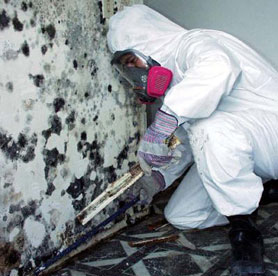
- Develop a suitable mold remediation plan. If abatement procedures are expected to generate a lot of dust (e.g., abrasive cleaning of contaminated surfaces, demolition of plaster walls) or the visible concentration of mold is heavy (i.e., blanket versus patchy coverage) follow the extensive contamination procedures below
- Consult with industrial hygienists or other environmental health and safety professionals with experience performing microbial investigations and/or mold remediation before beginning remediation
- The work area and areas directly adjacent to it should be unoccupied
- Cover surfaces in the work area and adjacent areas that could become contaminated with secured plastic sheets to contain dust and debris and prevent further contamination
- Seal ventilation ducts/grills in the work area and areas directly adjacent with plastic sheeting
- Use dust suppression methods (e.g., misting (not soaking) surfaces prior to remediation)
- Clean and/or remove materials as noted in the section above. Seal materials being removed in plastic bags
- The work and surrounding areas should be HEPA vacuumed and cleaned with a damp cloth or mop and a detergent solution
- All areas should be left dry and free from contamination and debris
Additional Personal Protective Equipment
-
See the PPE listed in the Mold/water damaged materials hazard
Key Engineering Controls and Work Practices
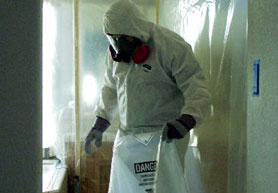
- Develop a suitable mold remediation plan. For remediation of extensive contamination (greater than 100 contiguous square feet in one area), the plan should address: work area isolation, the use of exhaust fans with HEPA filtration, and the design of airlocks/decontamination room
- Consult with industrial hygienists or other environmental health and safety professionals with experience performing microbial investigations and/or mold remediation before beginning remediation
- The work area should be unoccupied. If the containment practices listed below will keep mold spores from leaving the contained area, then it may not be necessary to remove people from surrounding areas. However, removal is still recommended for infants, persons recovering from surgery, immune suppressed people, or people with chronic inflammatory lung diseases (e.g., asthma, hypersensitivity pneumonitis, and severe allergies)
- Before beginning work, cover and seal other surfaces in the work area that could become contaminated with mold spores using plastic sheeting and duct tape; this will help contain dust and debris and prevent further contamination
- Contain the affected area. Completely isolate the area to be evaluated and remediated from occupied spaces using plastic sheeting, or other particulate barrier, sealed with duct tape. Use air locks at entry/exit points and provide a sealed decontamination room that is connected to the containment where mold remediation workers must remove PPE before exiting
- Shut off the HVAC system and seal ventilation ducts/grills in the work area and adjacent areas to prevent the spread of spores
- Keep the work area under negative pressure to minimize the spread of spores to adjacent areas. Use an exhaust fan equipped with HEPA filtration to maintain negative pressure
- Use dust suppression methods (e.g., misting (not soaking) surfaces prior to remediation)
- Clean and/or remove materials as noted in the section above. Seal materials being removed in plastic bags; wipe down or HEPA vacuum the outside surface of the bags of material being removed
- Before removing isolation barriers, HEPA vacuum the contained area and the decontamination room and then clean or mop it with a detergent
- Leave area clean, dry, and free of visible debris
Additional Personal Protective Equipment
-
See the PPE listed in the Mold/water damaged materials hazard
Key Engineering Controls and Work Practices
- Use the recommended work practices and isolation methods listed above; areas <10 square feet may be considered small isolated areas and area >10 square feet should be considered areas with extensive contamination
- Shut down the HVAC system before beginning remedial activities; consult with the building maintenance staff, engineer, or HVAC manufacturer to determine the correct procedures for shutting down system and to identify/locate system components and areas of potential contamination
- Consult with the HVAC manufacturer to determine which biocide they recommend for use on their HVAC system and components, such as cooling coils and condensation pans
- Remove contaminated materials that can support mold growth, such as the paper on the insulation of interior lined ducts and filters
- Inspect and clean HVAC system surfaces by removing all dirt, debris, and visible mold. Disinfect mold-impacted surfaces before reusing the system
- For extensively contaminated areas (i.e., > 10 square feet of contamination), air monitoring with the HVAC system running should be conducted prior to the re-occupancy
Additional Personal Protective Equipment
-
See the PPE listed in the Mold/water damaged materials hazard
Key Engineering Controls and Work Practices
-
Also see the Building Demolition activity sheet during demolition phases of mold remediation
Key Engineering Controls and Work Practices
-
See the Assessment, Cleanup, and Repair of Structures activity sheet during cleanup and reconstruction phases of mold remediation
Key Engineering Controls and Work Practices
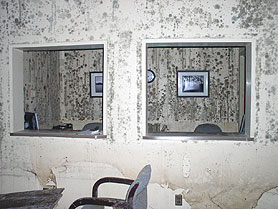
- Reduce the exposure to splash or aerosolized liquid hazards by limiting the number of people in the area and having those in the area stay upwind of water discharge areas
- Ensure that good hygiene, especially hand washing, is practiced before eating, drinking, and smoking. If clean water is not available, use an alternative such as hand sanitizer or sanitizing wipes
- Ensure that cuts and bruises are protected from contact with contaminated water
- Clean areas of the body that come in contact with contaminated water with soap and water, hand sanitizer, or sanitizing wipes
Additional Personal Protective Equipment
- Goggles if routinely working near splashing floodwater
- N, R, or P95 respirators may be necessary for exposure to contaminated water that may become aerosolized
- Watertight boots with steel toe and insoles
- Waterproof gloves for contact with contaminated water
Key Engineering Controls and Work Practices
- Take frequent rest/water breaks
- Wear light-colored clothing
- If response and recovery workers wear protective suits that do not "breathe" (which can increase the risk of heat stress), use the buddy system or observe the individuals to identify heat-related symptoms
- Also see general recommendations document
Select any of the following potential hazards that can be associated with this activity in order to access relevant recommendations in the general recommendations document:
- Environmental hazards
Additional Medical Needs
-
Follow medical guidance and precautions outlined in the general recommendations document.
Additional Training Needs
- Follow general site- and task-specific training guidelines as outlined in the general recommendations document.
-
Smaller remediation jobs may be conducted by regular building maintenance staff or other individuals who are trained on the hazards and exposure likely to be present (mold, cleaning materials, etc.), proper cleanup methods and work practices, and selection and use of personal protective equipment. This training can be performed as part of a program to comply with the requirements of the OSHA Hazard Communication Standard (29 CFR 1910.1200 and 29 CFR 1926.59). Larger remediation jobs (greater than 30 square feet) should be conducted by personnel that have additional training in mold remediation activities.
Related Activity Sheets
Other Resources and References
- Bardana, E. Indoor air quality and health: Does fungal contamination play a significant role? Immunological and Allergy Clin N Am. (23) 2003: 291-309
- 29 CFR 1910.134, Respiratory protection. OSHA Standard.
- A Brief Guide to Mold in the Workplace. OSHA Safety and Health Information Bulletin (SHIB), (2003).
- Fungi Hazards and Flood Cleanup. OSHA Fact Sheet, (2005).
- Mold. OSHA Fact Sheet, (2005).
- Mold. OSHA Safety and Health Topics Page.
- Storm/Flood and Hurricane Response. National Institute for Occupational Safety and Health (NIOSH) Workplace Safety and Health Topic.
- Mold Prevention Strategies and Possible Health Effects in the Aftermath of Hurricanes and Major Floods. Centers for Disease Control and Prevention (CDC), (2006). (Also available in: Mortality and Morbidity Weekly Report, June 9, 2006/55(RR08);1-27)
- Guidelines for the Protection and Training of Workers Engaged in Maintenance and Remediation Work Associated with Mold. National Clearinghouse for Worker Safety and Health Training, (2005).
- Mold Remediation in Schools and Commercial Buildings. Environmental Protection Agency (EPA), (March 2001).
- Guidelines on Assessment and Remediation of Fungi in Indoor Environments. New York City Department of Health and Mental Hygiene, (2008).
- Respirator Selection Logic 2004. Centers for Disease Control and Prevention (CDC), (October 2004).

